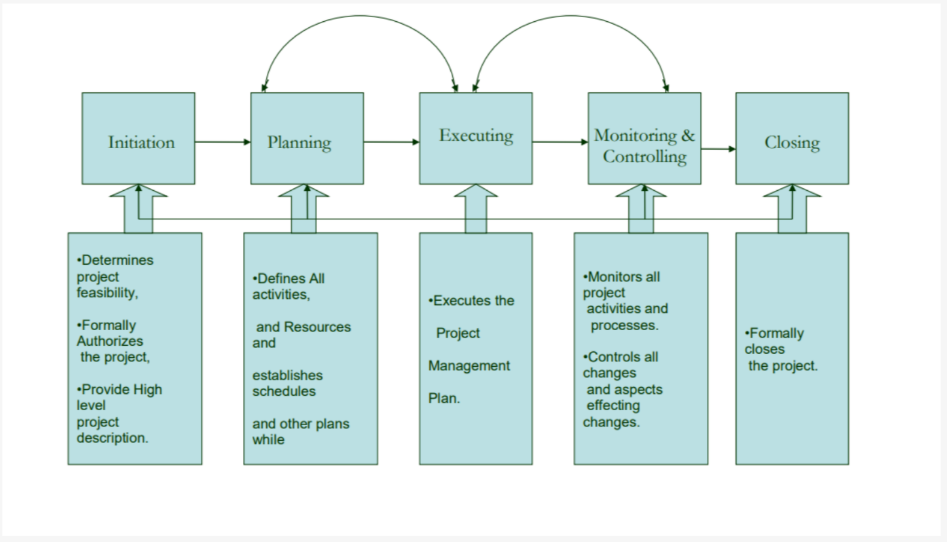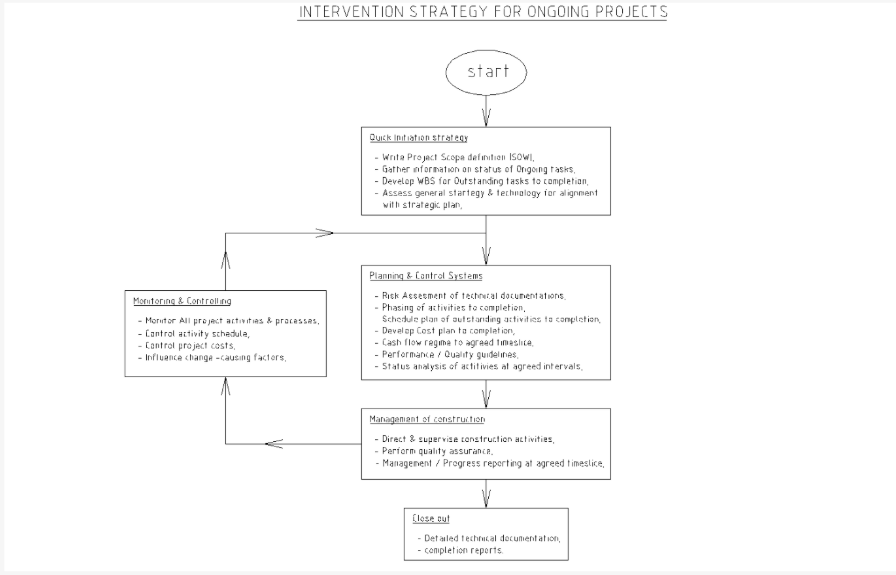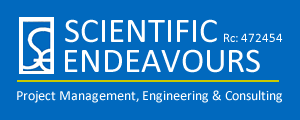
Project Management
For your project to be successful not only should it “get to market in the shortest time possible”, but that the product also meets your “brand / performance requirements”, at a price whereby “your money works for you in the best way possible”.
Scientific Endeavours (EF 1120) as standard practice carries out a thorough review of the technical documentations for the project regarding Safety / Fitness for purpose, the underlying assumptions / constraints, Completeness as well as consistence with available technology. The results of that review in negotiations with their originator(s) are fed into the final form of the technical documentations. The Scope management process (in full cognizance of those comments of the technical review exercise), is used to reconcile the Cost estimate as developed in the bills of quantities (where one already exists): otherwise a completely new bill of quantities is developed from scratch using comments/ recommendations of the technical review report.
That way the gaps that could have manifested in the technical and financial plans are closed (or at least greatly minimized); and indeed is the minimum initial “intervention” to qualify the baseline information whence other project plans are developed.
The Change management Criteria is also established here; thereby setting the framework for decision-making in balancing the project objectives as the product evolves.
Subsequently a detailed resource-driven Schedule plan is developed using the contractor’s method statement, thereby providing a strategy that enables managing across the true critical path. Other plans such as Cash flows (derived from inputting the project costs into the schedule plan), Quality control plan, Communications plan and Procurement plans etc follow suit (See summary of Project Management Process groups Deliverables).
Scientific Endeavours’ project leadership derives from nearly fifteen years of consistent and proven project management service delivery, coupled with over twenty five (25) years of consistent engineering practice. Our Principals & Associates are people with a high numeracy / computational background along with other connected skills. Thus resulting in no than 60% of our commissioned projects (averaged over the years 2004 to 2014). being delivered below budget, and 83.5% of projects managed from 2009 to 2012 delivered within budget.
We recognize a diversity of needs as much as there are diverse challenges in project delivery; therefore we created Customized solutions / Entry points (by no means an exhaustive list) for the generic / typical challenges encountered. However we still want to hear from you regarding that peculiar project delivery challenge
Figure 1 gives a broad outline of the process groups’ interaction from Initiation through Planning to Execution through Monitoring / Controlling and finally to Closing for application to a typical project
PROJECT MANAGEMENT PROCESS GROUPS INTERACTION

| S/N | Phase | Essential Activities | Specific PM Deliverables |
| 1 | Initiation | – Project feasibility – Formal authorization – High-level project definition | – Project Scope Statement |
| 2 | Planning | – Define all activities and resources – Establish schedules – Develop other plans | – Work Breakdown Structure (WBS) – Scope verification – Scope control – Responsibility Assignment Matrix – Change Management Control – Technical Risk Assessment (designs for safety, underlying assumptions, possible value-engineering, coordination of technical details with feedback integrated into final documentation) – Cost Estimate (Bills of Quantity) – Schedule Estimate (detailed resource-driven work program in MS Project 2010 using contractor’s method statement and acceptable logic) – Project Cash Flow (from schedule plan and cost estimate) – Quality Control Plan – Project Organization / Authority structure |
| 3 | Executing | – Execute the project management plan | – Minutes of meetings |
| 4 | Monitoring / Control | – Monitor all project activities and processes – Control all changes and change-causing factors | – Configuration management – Progress reports (bi-weekly or other suitable time slices) – Monthly report (capturing progress of activities, expenditure profiles, cost performance, earned values, look-ahead plans, cash flows, etc.) – Updates to program schedule – Re-planning as needed due to logic, scope, or other project changes – Periodic financial statements |
| 5 | Closeout | – Formally close the project | – Pre-handover report – As-built drawings – Final accounts – Completion certificate |
Competitive Edge
This section outlines three customized solutions or entry levels for project management services depending on client preference or the status of the project:
I) Bottom-up Roles (When PM Is Involved from the Very Start)
This represents the ideal involvement of the project manager throughout the project lifecycle, as summarized in the process groups’ interaction chart. The project manager participates from the initiation stage (rather than being brought in only after contract award to draw up a work program and monitor progress, with poorly articulated risks) and continues through planning, execution, monitoring/controlling, and closing.
Initiation Processes
- Provide and document a high-level description of the project using the Project Scope Statement or Statement of Work (SOW).
- Consider the overall strategy and technology for the project’s development and ensure alignment with the strategic plan.
- Define the Work Breakdown Structure (WBS).
- Establish responsibilities using the Responsibility Assignment Matrix (RAM).
- Define change management criteria in line with client requirements.
- Carry out risk identification and assessment, incorporating the results into the project’s technical documentation.
Planning Processes
- Define all activities and resources.
- Establish schedules and supporting plans, including:
- Phasing of activities based on project size
- Listing tasks needed before contract award
- Resolving interactions between these tasks on the timeline
- Assigning resources to pre-contract tasks
- Developing the schedule and driving tasks to completion within the allocated time
- Conducting technical risk management of deliverables at the pre-contract stage and incorporating adjustments into technical documentation
- Developing the procurement plan
- Developing the cost plan (Bills of Quantities and budgeting)
- Preparing a detailed, resource-driven schedule plan for the post-contract phase
- Developing and generating the cash flow projection for the post-contract phase
Execution / Monitoring & Controlling Processes
During execution, the Project Manager will:
- Direct and manage project execution
- Perform quality assurance
- Manage information distribution
- Oversee configuration management
During monitoring and controlling, the Project Manager will:
- Gather information on project activities (e.g., start times, completion status, resources used)
- Track scope and specification changes not stemming from project performance
- Measure overall project performance using earned value techniques by comparing actual progress against the baseline (schedule and cost)
- Control changes and recommend preventive actions
- Influence change-causing factors
- Communicate the overall project experience through progress and status reports at agreed intervals
- Provide periodic financial statements at agreed intervals
- Perform revised planning, updating, and providing feedback between phases
Closing Processes
- Prepare detailed technical documentation
- Produce completion reports
- Ensure product acceptance by the client
- Finalize accounts
II) Intervention / Recovery Plan for Distressed or Ongoing Projects
This scenario involves the project manager “jumping into” an ongoing or distressed project.
Quick Initiation Strategy
Given the emergency nature of such situations, planning efforts will involve backward integration of project definition. The project scope definition (or Statement of Work, SOW) is first documented based on assumptions and information from the existing contract documents.
Key steps include:
- Gathering information on the current status of activities completed so far
- Developing a Work Breakdown Structure (WBS) that outlines outstanding activities to completion
- Conducting a quick review of general strategy and technology to ensure alignment with strategic plans
- Establishing the Responsibility Assignment Matrix (RAM)
- Defining change management criteria
Planning Processes
- Once the WBS for the remaining activities is established, the following must be carried out:
- Perform a risk assessment of all technical documentation and integrate the results into these documents, distributing updates to all stakeholders
- Plan for:
- Phasing of activities to completion
- Cost to completion
- Schedule plan to completion
- Cash flow regime to completion
Management of Construction
The Project Manager is responsible for:
- Directing and managing construction activities
- Gathering information on project activities
- Measuring overall project performance using earned value techniques, comparing actual experience against the baseline plan
- Controlling changes and recommending preventive actions
- Influencing change-causing factors
- Communicating the entire project experience through progress and status reports at agreed intervals
- Performing revised planning, updates, and providing feedback between phases
Closing Processes
- Prepare detailed technical documentation
- Produce completion reports

III) Professional Advice & Support (to Existing Project Teams)
This solution provides professional guidance and support to existing project teams in the following areas:
Planning & Scheduling of Building / Civil Engineering Projects
(Regardless of size or complexity)
- Development of detailed resource-driven schedule plans
- Materials scheduling
- Cash flow planning with variable time slicing
- PERT charts
- Gantt charts
- Calendar view presentations (in A3 to A0 formats)
Project Management Facilitation for Projects
- Updates to schedule plans (including progress, resource usage, etc.)
- Status reporting (% completions, time loss, earliest completion dates, earned values, etc.)
- Re-planning in response to changes in method statements or activity logic
- Periodic expenditure and cost updates
Other Professional Services
- Intervention / Recovery plans for distressed projects (addressing schedule, cost, and quality plans)
- Cost advice and budget reviews for projects
- Enterprise-wide project management implementation
- Selection and evaluation of project management software
- Stringent Risk Management especially from design reviews of technical documentations, for correctness and consistency of underlying assumptions, has resulting in much fewer divergences in technical performance,
- Comprehensive scope planning ensures that work content meets the customer expectation by recognizing his constraints and appraising his assumptions, while capturing the risks that can influence the project objectives,
- Value engineering input presents opportunity for improved performance of project cost objectives,
- Demonstrated superior project integration management practice that joggles the variables (strategic direction, constraints, risks, resource requirements & change management), to ensure that project objectives are restored to their initial values. Or at least as closely as possible,
- Demonstrated project leadership acquired in over 15 years of consistent project management delivery, and over 25 years of sound engineering practice,
- Detailed schedule planning that captures all project tasks from initiation to close out (regardless of project size & complexity), and integrating resources, costs and agreed productivity. Thus providing the critical step in monitoring / controlling of schedule, while knowing precise status at any point in time at the click of the mouse,
- Superior project reporting that keeps management informed with extensive metrics; Earned values, Costs, Progress & performance status, with a clear recovery plan where deviations occur. Trends and look-ahead are also featured,
- 60% success ratio in bringing projects to completion within budget,
- Strength of Character through impartiality, Truthfulness, Integrity & Service.


